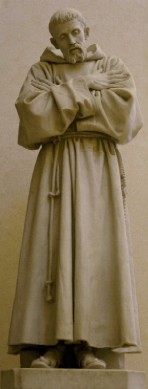
I just happened to be able to catch the first half of the Midnight Mass at the Vatican and was really surprised by what happened at the beginning of Mass.
It just surprised me because it is something we have done at our parish for several years, which is the singing of the Announcement of the Birth of Christ from the Roman Martyrology. We do it right before Mass (before the entrance hymn), and I noticed that at the Midnight Mass at Saint Peter's they sang it right before the Gloria.
I usually don't get to watch the Christmas Masses at the Vatican since I am usually working at the parish. So, I'm not sure if this is new or not.
I'm not sure if they sang the traditional Announcement or if they used the newer one from the 2004 Roman Martyrology. We use the traditional one because it is more beautiful. I find the newer one to have an "edited" feel to it.
I am not sure what tone it was sung in though. I've never heard that one. I don't think it was the traditional tone used for the singing of the Martyrology. When I sing it, I use the same tone which is sung at the Passion readings on Palm Sunday and Good Friday. I only do this because when we first started doing it, I couldn't find music for the Announcement, so I had to adapt it to a tone that was simple yet beautiful, and the Passion tones fit that.
Anyway, here are the entries, and you can compare the "traditional" entry with the more "modern" one.
Announcement of the Birth of Jesus Christ from the "traditional" Roman Martyrology
Latin
Anno a creatióne mundi, quando in princípio Deus creávit cœlum et terram, quínquies millésimo centésimo nonagésimo nono:
A dilúvio autem, anno bis millésimo nongentésimo quinquagésimo séptimo:
A nativitáte Abrahæ, anno bis millésimo quintodécimo:
A Moyse et egréssu pópuli Israel de Ægypto, anno millésimo quingentésimo décimo:
Ab unctióne David in Regem, anno millésimo trigésimo secúndo;
Hebdómada sexagésima quinta, juxta Daniélis prophetíam:
Olympíade centésima nonagésima quarta:
Ab urbe Roma cóndita, anno septingentésimo quinquagésimo secúndo:
Anno Impérii Octaviáni Augústi quadragésimo secúndo,
toto Orbe in pace compósito, sexta mundi ætáte,
Jesus Christus ætérnus Deus, æterníque Patris Fílius, mundum volens advéntu suo piíssimo consecráre,
de Spíritu Sancto concéptus, novémque post conceptiónem decúrsis ménsibus,
[HERE ALL KNEEL]
in Béthlehem Judæ náscitur ex María Vírgine factus Homo.
Natívitas Dómini nostri Jesu Christi secúndum carnem.
English
In the year five-thousand one-hundred and ninety-nine from the creation of the world,
when in the beginning God created the heavens and the earth;
In the year two-thousand nine-hundred and fifty-seven from the flood;
In the year two-thousand and fifty-one from the birth of Abraham;
In the year one-thousand five-hundred and ten from the going forth of the people of Israel out of Egypt under Moses;
In the year one-thousand and thirty-two from the anointing of David as king;
In the sixty-fifth week according to the prophecy of Daniel;
In the one-hundred and ninety-fourth Olympiad;
In the year seven-hundred and fifty-two from the foundation of the city of Rome;
In the forty-second year of the reign of the Emperor Octavian Augustus;
In the sixth age of the world, while the whole earth was at peace -
Jesus Christ, eternal God and the Son of the eternal Father, willing to consecrate the world by His gracious coming,
having been conceived of the Holy Spirit, and the nine months of His conception being now accomplished,
[HERE ALL KNEEL]
was born in Bethlehem of Judah of the Virgin Mary, and became Man.
The Nativity of our Lord Jesus Christ, according to the flesh.
Announcement of the Birth of Jesus Christ from the 2004 Roman Martyrology
Latin
Innúmeris transáctis saéculis a cratióne mundi, quando in princípio Deus creávit cælum et terram et hóminem formávit ad imáginem suam;
permúltis étiam saéculis, ex quo post dilúvium Altíssimus in núbibus arcum posúerat, signum foéderis et pacis;
a migratióne Abrahæ, patris nostri in fide, de Ur Chaldæórum saéculo vigésimo primo;
ab egréssu pópuli Israel de Ægýpto, Móyse duce, saéculo décim tértio;
ab unctióne David in regem anno círciter millésimo,
hebdómada sexagésima quinta, iuxta Daniélis prophetíam;
Olympíade centésima nonagésima quarta;
ab Urbe cóndita anno septingentésimo quinquagésimo secúndo;
anno impérii Caésaris Octaviáni Augústi quadragésimo secúndo;
toto Orbe in pace compósito, Iesus Christus, ætérnus Deus æterníque Patris Fílius, mundum volens advéntu suo piíssimo consecráre, de Spíritu Sancto concéptus, novémque post conceptiónem decúrsis ménsibus,
in Béthlehem Iudæ náscitur ex María Vírgine factus homo:
Natívitas Dómini nostri Iesu Christi secúndum carnem.
English
Innumerable ages having passed since the creation of the world, when in the beginning God created Heaven and earth, and formed man in His image;
and in the very many centuries, in which, after the flood, the Most High placed an arch in the clouds, a sign of a covenant and of peace;
twenty one centuries from the departure of Abraham, our father in faith, from Ur of the Chaldeans;
about a thousand years after the anointing of David as king, in the sixty fifth week according to the prophecy of Daniel;
in the one hundred and ninety fourth Olympiad;
seven hundred and fifty two years after the founding of the City (of Rome)
in the forty second year of the emperor Octavian Augustus Caesar;
while the whole world was ordered in peace, Jesus Christ, eternal God and eternal Son of the Father, wishing to consecrate the world by His most gracious coming, having been conceived by the Holy Spirit, and the nine months of His conception having passed,
was born in Bethlehem of Judah of the Virgin Mary, and became man:
The birth of our Lord Jesus Christ according to the flesh.

RS






3 comments:
great post..
At my Dallas parish, the priest insisted that the "evidence" has indicated that Jesus was not born in December, but sometime between April and September.
Conversely, the following is an excerpt from a Web site that insists that Jesus was born on December 25.
What is your opinion of the following?
"The conception of St. John is our linchpin for establishing the date of the Birth of our Lord Jesus Christ. The rest is simple to calculate.
"Six 30-day months from September 23 bring us to March 25, the date of the Annunciation (Luke 1:26).
"Another nine months, the normal human gestation period, bring us to December 25.
"There is no record of the feast ever having been celebrated in the Church on any date other than December 25.
"Antiquity, universality, and consent ("everywhere, always, and by all"), clearly favors December 25 as the date when our Lord was born."
I guess I find the question of the exact date rather moot, which is why I find the re-wording of the traditional announcement so unnecessary.
Post a Comment